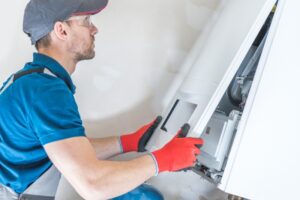
We should start off by saying, gas furnaces are not inherently dangerous appliances. You should never panic just because you use a gas-powered appliance in your home. However, just like any other appliance or home comfort system, your gas furnace needs to be well cared for so you can avoid it becoming potentially dangerous.
The fact of the matter is, it produces combustion gasses when it operates and those combustion gases have the potential to lead to harmful consequences, such as carbon monoxide exposure. Treat your gas furnace well, and you should have few worries about its operation.
But an ill-maintained furnace could potentially suffer from expedited wear and tear, leading to a cracked heat exchanger, which is where problems happen. This is a more common problem in aging systems (10-15 years old) but is still something you should be aware of if you have a gas-powered system, no matter the age. So, what’s a heat exchanger and why is a cracked one bad news?
What a Heat Exchanger Is
The heat exchanger is a vital part of your gas-powered furnace. It’s the component in which the heat form the combustion gas safely transfers to the air from the blower fan that moves through your ventilation system.
The combustion gases that accumulate in the heat exchanger are not supposed to come into contact with the air that enters your home—that is what leads to potentially dangerous carbon monoxide leaks and CO poisoning.
Instead, the combustion gas enters the heat exchanger, which is a metal clamshell-shaped chamber. The heat of the combustion gasses raises the temperature of the metal walls, and when the air blows over it, it picks up the heat. Then, the combustion gases are released as exhaust through a flue.
Why Is It Bad If You Have a Cracked Heat Exchanger?
We mentioned CO (carbon monoxide) above—this is a colorless, tasteless, odorless gas that has the potential to lead to serious illnesses and even fatalities. If you have a cracked heat exchanger, then that CO can leak from it and into the air coming through your living space.
The most likely cause for heat exchanger damage is corrosion. The reaction between the combustion gas and metal over time can create a weakening in the metal walls of the heat exchanger. This is why we mentioned that it’s something to watch out for in older furnaces. Even the smallest crack can be a problem since it will stretch wider as the heat exchanger warms up and expands. If you notice a clicking noise coming from your furnace after the blower shuts off, it could be the sound of a heat exchanger contracting as it cools down, but it will only make this noise if it has a crack in it. If you hear this noise, or if your CO detectors go off, it’s time to shut off your furnace and give our team a call right away for repairs—or depending on how severe the problem is even a replacement.
Contact us for quality furnace service in St. Helena, CA. Jonas Energy Solutions: Become a Part of the Solution!
